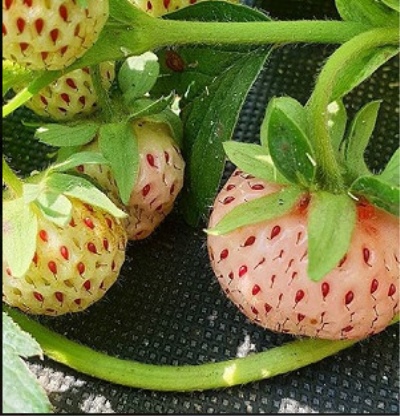
- Authors: France
- Taste: sweet, pineapple
- The size: average
- Weight: 20 - 30 g
- Yield rate: high
- Ripening terms: medium
- Advantages: can be used by people prone to allergies; fruits are not destroyed by birds
- Appointment: fresh consumption, processing (juice, jam, jam, etc.)
- Description of the bush: compact, tall
- Berry color: White
Anablanca, a French variety of white strawberries, has won the hearts of gardeners far beyond the borders of its homeland. The fruits do not contain red pigment that provokes the development of allergic reactions; even children and people prone to allergies eat them without fear. Low transportability limits the range of berry application to processing and fresh consumption on harvest days.
Description of the variety
Anablanca is characterized by the formation of compact tall bushes. They feel good in a tight fit. The color of the leaves is green, the peduncles are not too tall. They tend to droop under the weight of the berries.
Ripening terms
The variety has an average berry ripening period. Fruiting begins in May and lasts until mid-June. In cold regions, these periods are shifted by 2-3 weeks.
Yield
The high degree of productivity allows you to grow Anablanca on the site to create blanks for the winter.
Berries and their taste
The fruit of the Anablanca strawberry is its main advantage. The white skin tone with expressive red achenes hides the juicy flesh with a sweet pineapple flavor. The fruits are medium in size, round in shape, reaching a mass of 20-30 g.
Growing features
Anablanca is an easy-care strawberry variety. Plants adapt equally well to dry periods, frosts, and successfully winter in the climate of central Russia. In warm climates, the cultivar may show repeated fruiting. Anablanca is well suited for growing in a pot culture. It can be planted in flowerpots with a diameter of 12-14 cm.
Despite the fact that Anablanca strawberries are very unpretentious, they are shown annual spring or autumn pruning. So you can remove the extra load from the bush in the form of a mustache and old leaves. Pruning is carried out on the lower parts of the crown, locally. Excess mustache can be removed in the summer.




Site selection and soil preparation
Berries turn pink when plants are planted in the open sun. Therefore, for the cultivation of Anablanca, they choose semi-shady areas. It is important that the soil is not too wet - this indicator negatively affects the wateriness of the pulp, while the sweetness and characteristic taste remains. At the stage of soil preparation, care should be taken to introduce a complex of nitrogen-potassium-phosphorus fertilizing. This stock will be enough for bushes for 1 year of growth.

Pollination
Cross-pollination is not required. The hybrid variety successfully copes with this process without neighboring plants.

One of the important techniques in strawberry care is feeding. Regular fertilization guarantees a rich harvest. There are several different ways to feed strawberries, and each of them is designed for a specific period of plant development. During flowering, fruiting and after it, feeding should be different.

Diseases and pests
Resistance to diseases and pests is average. Bushes almost do not attract the attention of birds, which has a beneficial effect on the safety of the crop. Despite the compliance of the plant's natural defenses with European standards, Anablanca strawberries should still be additionally protected by prophylactic spraying with chemical fungicides. And also wood ash will help scare off pests.
The danger to Anablanca is posed by such pests as nematodes, spider mites, and weevils. Of the fungal diseases, gray rot is most common. Affected bushes are destroyed so as not to infect the entire plantation.

Strawberries are often subject to many dangerous diseases that can seriously undermine their condition. Among the most common are powdery mildew, gray mold, brown spot, anthracnose, and verticillosis. Before buying a variety, you need to inquire about its disease resistance.
Reproduction
The main breeding method of the Anablanca variety is with a mustache. An average number of them is formed on the bushes. First, the mustache is rooted in separate plastic containers, pots, containers, and then separated from the mother bush.

Review overview
According to summer residents, Anablanca still looks rather unusual for the Russian climate. The snow-white berries attract attention, but the taste seems too unusual, and the lack of the familiar brightness of the color only adds to the alertness. Difficulties arise with the purchase of planting material. Young bushes with a closed root system are difficult to get, and when grown from seeds, germination is very low.It is noted that after planting in the soil, fruiting most often has to wait only for the next year.
A special interest in Anablanca is shown by lovers of container gardening, who want to extend the period of its fruiting due to renovation. Often, the variety is chosen solely for its hypoallergenicity, planting several bushes for children. It is noted that this pineapple strawberry is surprisingly unpretentious, it is even easier to grow it than the regular red one.


















































































